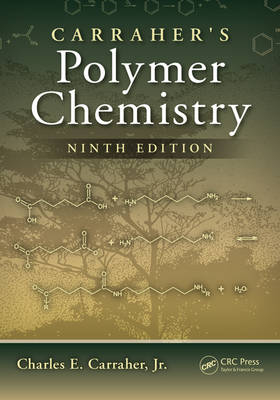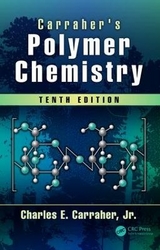
Carraher's Polymer Chemistry, Ninth Edition
Crc Press Inc (Verlag)
978-1-4665-5203-6 (ISBN)
- Titel erscheint in neuer Auflage
- Artikel merken
Using simple fundamentals, this book demonstrates how the basic principles of one polymer group can be applied to all of the other groups. It covers reactivities, synthesis and polymerization reactions, techniques for characterization and analysis, energy absorption and thermal conductivity, physical and optical properties, and practical applications. This edition includes updated techniques, new sections on a number of copolymers, expanded emphasis on nanotechnology and nanomaterials, and increased coverage of topics including carbon nanotubes, tapes and glues, photochemistry, and more.
With topics presented so students can understand polymer science even if certain parts of the text are skipped, this book is suitable as an undergraduate as well as an introductory graduate-level text. The author begins most chapters with theory followed by application, and generally addresses the most critical topics first. He provides all of the elements of an introductory text, covering synthesis, properties, applications, and characterization. This user-friendly book also contains definitions, learning objectives, questions, and additional reading in each chapter.
Charles E. Carraher, Jr., is a professor of chemistry and biochemistry at Florida Atlantic University, Boca Raton, and associate director of the Florida Center for Environmental Studies, Palm Beach Gardens. He was recognized as the most outstanding chemist in the southeastern United States (1992) by the American Chemical Society (ACS). Dr. Carraher currently serves as co-chair of the ACS’s Joint Polymer Education Committee, on the board of the Intersocietal Polymer Education Committee, and has been a member of the ACS’s Committee on Professional Training (CPT). He also serves as an associate editor of the Journal of Polymeric Materials and on the board of the Journal of Inorganic and Organometallic Polymers and Materials and the Journal Chinese Advanced Materials Society. The author or co-editor of about 70 books and over 1,000 articles, Dr. Carraher has chaired/co-chaired numerous national and international symposia. His research has led to the synthesis of over 75 new families of polymers.
Introduction to Polymers
History of Polymers
Why Polymers?
Today’s Marketplace
Environmental Assessment
Polymer Structure (Morphology)
Stereochemistry of Polymers
Molecular Interactions
Polymer Crystals
Amorphous Bulk State
Polymer Structure–Property Relationships
Cross-Linking
Crystalline and Amorphous Combinations
Molecular Weight of Polymers
Introduction
Solubility
Average Molecular Weight Values
Fractionation of Polydisperse Systems
Chromatography
Colligative Molecular Weights
Light-Scattering Photometry
Other Techniques
Viscometry
Polycondensation Polymers (Step-Reaction Polymerization)
Comparison between Polymer Type and Kinetics of Polymerization
Introduction
Stepwise Kinetics
Polycondensation Mechanisms
Polyesters
Polycarbonates
Synthetic Polyamides
Polyimides
Polyamide-Imide
Polybenzimidazoles and Related Polymers
Polyurethanes and Polyureas
Polysulfides
Polyethers and Epoxies
Polysulfones
Poly(Ether Ether Ketone) and Polyketones
Phenolic and Amino Plastics
Furan Resins
Synthetic Routes
Liquid Crystals
Microfibers
General Stepwise Polymerization
Ionic Chain-Reaction and Complex Coordination Polymerization (Addition Polymerization)
Cationic Polymerization
Anionic Polymerization
Stereoregularity
Polymerization with Complex Coordination Catalysts
Soluble Stereoregulating Catalysis
Polyethylenes
Polypropylene
Polymers from 1,4-Dienes
Polyisobutylene
Metathesis Reactions
Zwitterionic Polymerization
Isomerization Polymerization
Precipitation Polymerization
Free-Radical Chain Polymerization (Addition Polymerization)
Initiators for Free-Radical Chain Polymerization
Mechanism for Free-Radical Chain Polymerization
Chain Transfer
Polymerization Techniques
Fluorine-Containing Polymers
Polystyrene
Poly(Vinyl Chloride)
Poly(Methyl Methacrylate)
Poly(Vinyl Alcohol) and Poly(Vinyl Acetals)
Polyacrylonitrile
Solid-State Irradiation Polymerization
Plasma Polymerizations
Copolymerization
Kinetics of Copolymerization
Q-e Scheme
Commercial Copolymers
Block Copolymers
Graft Copolymers
Elastomers
Thermoplastic Elastomers
Blends
Fluoroelastomers
Nitrile Rubber
Acrylonitrile–Butadiene–Styrene Terpolymers
EPDM Rubber
Networks: General
Polymer Mixtures
Dendrites
Ionomers
Viscosity Modifiers
Composites and Fillers
Fillers
Types of Composites
Long-Fiber Composites: Theory
Fibers and Resins
Long-Fiber Composites: Applications
Nanocomposites
Fabrication
Metal-Matrix Composites
Naturally Occurring Polymers: Plants
Polysaccharides
Cellulose
Paper
Cellulose-Regenerating Processes
Esters and Ethers of Cellulose
Starch
Homopolysaccharides
Heteropolysaccharides
Synthetic Rubbers
Naturally Occurring Polyisoprenes
Resins
Balloons
Lignin
Melanins
Asphalt
Naturally Occurring Polymers: Animals
Proteins
Levels of Protein Structure
Nucleic Acids
Flow of Biological Information
RNA Interference
Polymer Structure
Protein Folding
Genetic Engineering
DNA Profiling
Human Genome: General
Chromosomes
Spliceosomes
Proteomics
Protein Site Activity Identification
Organometallic and Inorganic–Organic Polymers
Introduction
Inorganic Reaction Mechanisms
Condensation Organometallic Polymers
Coordination Polymers
Addition Polymers
Ion-Exchange Resins
Inorganic Polymers
Introduction
Portland Cement
Other Cements
Silicates
Silicon Dioxide (Amorphous)
Kinds of Amorphous Glass
Safety Glass
Lenses
Solgel
Aerogels
Silicon Dioxide (Crystalline Forms): Quartz Forms
Silicon Dioxide in Electronic Chips
Silicon Dioxide in Optical Fibers
Asbestos
Fly Ash and Aluminosilicates
Polymeric Carbon: Diamond
Polymeric Carbon: Graphite
Internal Cyclization: Carbon Fibers and Related Materials
Carbon Nanotubes
Bitumens
Carbon Black
Polysulfur
Ceramics
High-Temperature Superconductors
Zeolites
Testing and Spectrometric Characterization of Polymers
Spectronic Characterization of Polymers
Surface Characterization
Amorphous Region Determinations
Mass Spectrometry
Thermal Analysis
Thermal Property Tests
Flammability
Electric Properties: Theory
Electric Measurements
Optical Property Tests
Weatherability
Chemical Resistance
Measurement of Particle Size
Measurement of Adhesion
Permeability and Diffusion
Rheology and Physical Tests
Rheology
Typical Stress–Strain Behavior
Stress–Strain Relationships
Specific Physical Tests
Additives
Plasticizers
Antioxidants
Heat Stabilizers
Ultraviolet Stabilizers
Flame Retardants
Colorants
Curing Agents
Antistatic Agents: Antistats
Chemical Blowing Agents
Compatibilizers
Impact Modifiers
Processing Aids
Lubricants
Microorganism Inhibitors
Reactions on Polymers
Reactions with Polyolefins and Polyenes
Reactions of Aromatic and Aliphatic Pendant Groups
Degradation
Cross-Linking
Reactivities of End Groups
Supramolecules and Self-Assembly
Transfer and Retention of Oxygen
Nature’s Macromolecular Catalysts
Photosynthesis
Mechanisms of Physical Energy Absorption
Breakage of Polymeric Materials
Synthesis of Reactants and Intermediates for Polymers
Monomer Synthesis from Basic Feedstocks
Reactants for Step-Reaction Polymerization
Synthesis of Vinyl Monomers
Synthesis of Free-Radical Initiators
Polymer Technology
Fibers
Elastomers
Films and Sheets
Polymeric Foams
Reinforced Plastics (Composites) and Laminates
Molding
Casting
Extrusion
Coatings
Adhesives
Selected Topics
Conductive Polymeric Materials
Nonlinear Optical Behavior
Photophysics and Photochemistry: Basics
Drug Design and Activity
Synthetic Biomedical Polymers
Sutures
Geotextiles
Smart Materials
High-Performance Thermoplastics
Construction and Building
Flame-Resistant Textiles
Water-Soluble Polymers
Anaerobic Adhesives
Hydrogels
Emerging Polymers
Green Materials
New Materials: Additional Aspects
Solutions
Appendix A: Symbols
Appendix B: Trade Names
Appendix C: Syllabus
Appendix D: Polymer Core Course Committees
Appendix E: Structures of Common Polymers
Appendix F: Mathematical Values and Units
Appendix G: Comments on Health
Appendix H: ISO 9000 and 14000
Appendix I: Electronic Education Websites
Index
| Erscheint lt. Verlag | 5.9.2013 |
|---|---|
| Zusatzinfo | approx 800 equations; 127 Tables, black and white; 634 Illustrations, black and white |
| Verlagsort | Bosa Roca |
| Sprache | englisch |
| Maße | 178 x 254 mm |
| Gewicht | 1586 g |
| Themenwelt | Naturwissenschaften ► Chemie ► Organische Chemie |
| Technik ► Maschinenbau | |
| ISBN-10 | 1-4665-5203-4 / 1466552034 |
| ISBN-13 | 978-1-4665-5203-6 / 9781466552036 |
| Zustand | Neuware |
| Haben Sie eine Frage zum Produkt? |
aus dem Bereich



